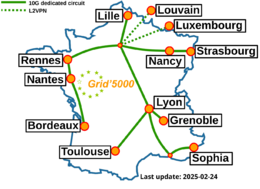Grid5000:Home
|
Grid'5000 is a precursor infrastructure of SLICES-RI, Scientific Large Scale Infrastructure for Computing/Communication Experimental Studies.
|
|
Grid'5000 is a large-scale and flexible testbed for experiment-driven research in all areas of computer science, with a focus on parallel and distributed computing, including Cloud, HPC, Big Data and AI. Key features:
Older documents:
|
Random pick of publications
Five random publications that benefited from Grid'5000 (at least 2928 overall):
- Louis Roussel. Integral Equations Modelling and Deep Learning. Computer Science cs. Université de Lille, 2025. English. NNT : . tel-05425240 view on HAL pdf
- Sofía Callejas, Hernan Lira, Andrew Berry, Luis Martí, Nayat Sanchez-Pi. No Plankton Left Behind: Preliminary results on massive plankton image recognition. 1th Latin American High Performance Computing Conference - CARLA 2024, Ginés Guerrero; Jaime San Martín; Esteban Meneses; Carlos J Barrios H; Carla Osthoff; Jose M Monsalve Diaz, Sep 2024, Santiago de Chile, Chile. hal-04803602 view on HAL pdf
- Mostafa Sadeghi, Romain Serizel. Posterior sampling algorithms for unsupervised speech enhancement with recurrent variational autoencoder. International Conference on Acoustics Speech and Signal Processing (ICASSP), IEEE, Apr 2024, Seoul (Korea), South Korea. 10.48550/arXiv.2309.10439. hal-04210679v2 view on HAL pdf
- Hee-Soo Choi, Priyansh Trivedi, Mathieu Constant, Karën Fort, Bruno Guillaume. Beyond Model Performance: Can Link Prediction Enrich French Lexical Graphs?. The 2024 Joint International Conference on Computational Linguistics, Language Resources and Evaluation (LREC-COLING), May 2024, Turin, Italy. hal-04537462 view on HAL pdf
- Hugo Thomas, Guillaume Gravier, Pascale Sébillot. Recherche de relation à partir d’un seul exemple fondée sur un modèle N-way K-shot : une histoire de distracteurs. 35èmes Journées d'Études sur la Parole (JEP 2024) 31ème Conférence sur le Traitement Automatique des Langues Naturelles (TALN 2024) 26ème Rencontre des Étudiants Chercheurs en Informatique pour le Traitement Automatique des Langues (RECITAL 2024), Jul 2024, Toulouse, France. pp.157-168. hal-04623015 view on HAL pdf
Latest news
![]() End of support for centOS7/8 and centOSStream8 environments
End of support for centOS7/8 and centOSStream8 environments
Support for the centOS7/8 and centOSStream8 kadeploy environments is stopped due to the end of upstream support and compatibility issues with recent hardware.
The last version of the centOS7 environments (version 2024071117), centOS8 environments (version 2024071119), centOSStream8 environments (version 2024070316) will remain available on /grid5000. Older versions can still be accessed in the archive directory (see /grid5000/README.unmaintained-envs for more information).
-- Grid'5000 Team 08:44, 4 December 2025 (CEST)
![]() Ecotaxe cluster is now in default queue at Nantes
Ecotaxe cluster is now in default queue at Nantes
We are pleased to announce that the ecotaxe cluster of Nantes is now available in the default queue.
As a reminder, ecotaxe is a cluster composed of 2 HPE ProLiant DL385 Gen10 Plus v2 servers[1].
Each node features:
To submit a job on this cluster, the following command may be used:
oarsub -t exotic -p ecotaxe
This cluster is co-funded by Région Pays de la Loire, FEDER and REACT EU via the CPER SAMURAI [3].
[1] https://www.grid5000.fr/w/Nantes:Hardware#ecotaxe
[2] The observed throughput depends on multiple parameters such as the workload, the number of streams, ... [3] https://www.imt-atlantique.fr/fr/recherche-innovation/collaborer/projet/samurai
-- Grid'5000 Team 14:10, 02 December 2025 (CET)
![]() Some changes on the hardware configuration of Grenoble nodes
Some changes on the hardware configuration of Grenoble nodes
We recently did some hardware changes on clusters yeti, troll and dahu.
The changes are as follows:
- yeti-[1,3]: 1× NVMe
- yeti-[2,4]: 2× NVMe
oarsub request. For example:oarsub -I -p "dahu and opa_count > 0"
-- Grid'5000 Team 14:50, 24 November 2025 (CEST)
![]() Cluster "clervaux" is now in the default queue in Luxembourg
Cluster "clervaux" is now in the default queue in Luxembourg
We are pleased to announce that the clervaux[1] cluster of Luxembourg is now available in the default queue.
Clervaux is a cluster composed of 48 CPU nodes.
Each node features:
This cluster was funded by the University of Luxembourg.
[1] https://www.grid5000.fr/w/Luxembourg:Hardware#clervaux
-- Grid'5000 Team 10:50, 21 October 2025 (CEST)
Grid'5000 sites
Current funding
INRIA |
CNRS |
UniversitiesIMT Atlantique |
Regional councilsAquitaine |



